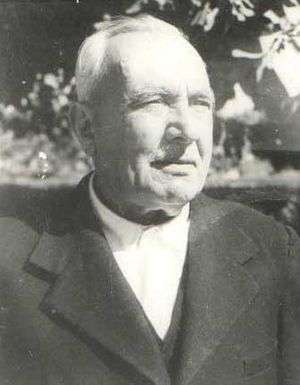Khan Abdul Jabbar Khan
| Abdul Jabbar Khan | |
|---|---|
 | |
| 1st Chief Minister of West Pakistan | |
|
In office 14 October 1955 – 27 August 1957 | |
| Monarch | Elizabeth II |
| President | Iskander Mirza |
| Governor-General | Iskander Mirza |
| Governor | Mushtaq Ahmed Gurmani |
| Preceded by | First |
| Succeeded by | Sardar Abdur Rashid Khan |
Khan Abdul Jabbar Khan (Pashto: خان عبدالجبار خان) ( born 1882, Utmanzai – 9 May 1958, Lahore), popularly known as Dr. Khan Sahib, was a pioneer in the Indian Independence Movement and a Pakistani politician.
Early life
He was born in the village of Utmanzai, in the North West Frontier Province (NWFP) of British India (now in Khyber-Pakhtunkhwa, Pakistan). His father, Bahram Khan was a local landlord. He was eight years older than his brother, Khan Abdul Ghaffar Khan (Bacha Khan).
After matriculating from the Edwards Mission High School in Peshawar, Khan Sahib studied at Grant Medical College, Bombay now Mumbai . He subsequently completed his training from St Thomas' Hospital in London. During the first World War he served in France, and after the war, he joined the Indian Medical Service and was posted in Mardan with the Guides regiment. He resigned his commission in 1921, after refusing to be posted in Waziristan, where the British Indian Army was launching operations against fellow Pakhtuns.
Contribution to the Indian independence movement
In 1935, Khan Sahib was elected alongside Peer Shahenshah of Jungle Khel Kohat as representatives of the North-West Frontier Province to the Central Legislative Assembly in New Delhi.
With the grant of limited self-government and announcement of provincial elections in 1937, Dr. Khan Sahib led his party to a comprehensive victory. The Frontier National Congress, an affiliate of the Indian National Congress emerged as the single largest party in the Provincial Assembly.
Politics in Pakistan 1947 – 1954
At the time of independence, he was the chief minister. Later he was jailed by Abdul Qayyum Khan's government. After Qayyum Khan's appointment to the Central government and the personal efforts of the Chief Minister of Khyber-Pakhtunkhwa at the time, Sardar Bahadur Khan, he along with his brother and many other activists were released.
Back in government
He joined the Central Cabinet of Muhammad Ali Bogra as Minister for Communications in 1954. This decision to join the government led to his split with his brother.[1]
In October 1955, he became the first Chief Minister of West Pakistan following the amalgamation of the provinces and princely states under the One Unit scheme. After differences with the ruling Muslim League over the issue of Joint versus Separate Electorates, he created the Republican Party.
He resigned in March 1957 after the provincial budget was rejected by the assembly.
In June, he was elected to the National Assembly representing the constituency of Quetta, the former capital of Balochistan.
Assassination
He was assassinated by Atta Mohammad at approximately 8:30 am on 9 May 1958, according to some sources on the orders of the Allama Mashraqi, leader of the Khaksars.[2]
This tragic incident occurred while Dr. Khan Sahib was sitting in the garden of his son Sadullah Khan's house at 16 Aikman Road, GOR, Lahore.[3] He was waiting for Colonel Syed Abid Hussein of Jhang to accompany him to a meeting organised in connection with the scheduled February 1959 General Elections. The assailant was a "Patwari" (Land Revenue Clerk) from Mianwali who had been dismissed from service two years previously.
The body of Dr. Khan Sahib was taken to his village Utmanzai in Charsadda about 30 miles from Peshawar, where he was laid to rest by side of his English wife Mary Khan. All West Pakistan Government offices remained closed on 9 May and flags flew at half-mast in memory of Dr. Khan Sahib.[4]
Speaking of his passing, Pakistani President Iskander Mirza said, about him that he was "the greatest Pathan of his times, a great leader and a gallant gentleman whose life-long fight in the cause of freedom, his sufferings and sacrifices for the sake of his convictions and his passion to do good to the common man were the attributes of a really great man."[5]
Dr. Khan Sahib was survived by three sons.
After his death, Nawab Akbar Khan Bugti was elected to fill the vacancy arising in the National Assembly.
It is important to note that Dr.Khan Sahib's brother, Abdul Ghaffar Khan and his Red Shirt movement stayed away from the electoral politics.
References
- ↑ Victoria Schofield Afghan (2004)Frontier: Feuding and Fighting in Central Asia. Tauris Parke Paperbacks,
- ↑ Dr Ali Muhammad Khan, 'Allama Mashriqi , Khaksar Tehreek aur uss ki Qatilana Siyasat' (Urdu: Allama Mashriqi, the Khaksars and the Politics of Assassination') pub Lahore: Rang Mahal Publishers, 1978, pp 121-123
- ↑ Khan, p 121
- ↑ The Hindu : Miscellaneous / This Day That Age : dated 10 May 1958: Khan Sahib assassinated
- ↑ Frontier Post, 27 May 2004 Dr Khan Sahib Remembered By Syed Afzaal Hussain Zaidi
Notes
- Mahmud, Makhdumzada Syed Hassan (1958). A Nation is Born
See also
- Khan Abdul Bahram Khan
- Khan Abdul Ghani Khan
- Khan Abdul Ghaffar Khan
- Khan Abdul Wali Khan
- Nasim Wali Khan
- Asfandyar Wali Khan
| Political offices | ||
|---|---|---|
| Preceded by Sahibzada Abdul Qayyum |
Chief Minister of Khyber-Pakhtunkhwa 1937–1939 |
Succeeded by Sardar Aurang Zeb Khan |
| Preceded by Sardar Aurang Zeb Khan |
2nd term 1945–1946 |
Succeeded by 3rd term |
| Preceded by 2nd term |
3rd term 1946–1947 |
Succeeded by Abdul Qayyum Khan |
| Preceded by Office created |
Chief Minister of West Pakistan 1955–1957 |
Succeeded by Sardar Abdur Rashid Khan |